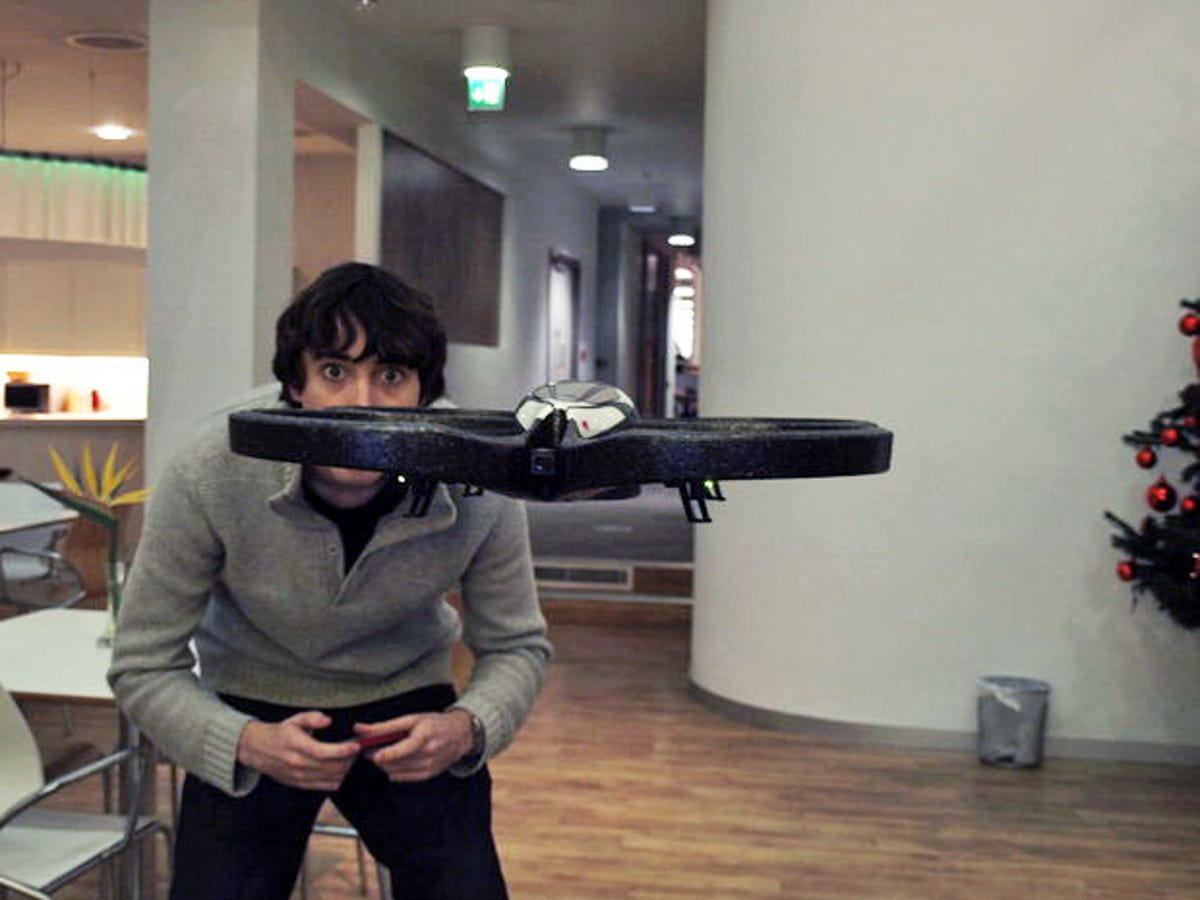
At some point we've all wandered over to a large bay window, gazed out over the dreary moors and said to ourselves: "Oh, how I wish I could use my iPhone, iPad or iPod touch to remotely pilot a hovering helicopter over these hills, and laugh like a madman as terrified wildlife flees at the sight of its monstrous, camera-laden visage."
Our prayers have been answered by the Parrot AR.Drone -- the coolest gadget we've seen in a long, long time. We originally spotted this hovering hellion way back in January at CES 2010. Since then, we've been chewing our knuckles off in waiting to get a proper hands-on session with it. Now we have it and we're ready to spill the beans. It'll cost you around £300.
What the heck is this thing?
The AR.Drone is a remote-controlled quadricopter (a helicopter with four rotors) that emits its own Wi-Fi signal. If you own an iPod touch, iPad or iPhone, you can download a special application and use it to pilot the AR.Drone. There's a camera on the front of the machine, and video from this camera will be relayed via the Wi-Fi connection to your iDevice's screen, so you can see what the AR.Drone sees.
That's right -- it's like a spy plane, even if it is as loud as a vacuum cleaner. But how will any budding Bonds fare when it comes to getting the AR.Drone up and running?
Setting it up
The AR.Drone requires little assembly. You'll need to charge the battery, though, and then slide the two halves of the device apart to insert the battery into its compartment. Once plugged in, lights should come on around each propeller. We didn't find this process too tricky.
We found it more troublesome to get the AR.Drone to play nicely with our iPhone. Firing up the Wi-Fi menu on your device should reveal a special Wi-Fi signal being pumped out by the AR.Drone, and, theoretically, all you need to do is connect to this to get started.
We had trouble initially, though. This was probably because our review sample had been connected to other iPhones before we received it. As such, we had to use a paper clip to press the tiny 'unpair' button on the craft's underside. That switch isn't labelled, so we had to do some crafty Googling, and found our answer on the AR.Drone support page.
Once this was sorted, we installed the app. There's a free version called Free Flight, or a £1.80 AR.Pursuit version that includes a game. We downloaded the Free Flight application, and we were ready to fly.
We didn't encounter any huge stumbling blocks in getting the AR.Drone flying, but it hardly leapt out of the box and into the air.
Pitch and yawsome
Here's how you control the AR.Drone. The iPhone's screen contains two main virtual buttons. When you hold down the left button, tilting the iPhone will cause the AR.Drone to move forward, backwards or from side to side in a strafing fashion. If you press nothing, the Drone will hover in place.
The other button works as a joystick. It has four directions -- moving it up and down will raise or lower the AR.Drone on the spot, and moving it left or right will rotate the quadricopter.
Flying accurately takes some getting used to, because you have to consider every move from the chopper's point of view. For example, we instinctively tilted the phone to the left when we wanted the AR.Drone to move left. But, if it's facing you, that won't work -- the AR.Drone will move to the right.
Once you're used to it, however, flying the AR.Drone proves impressively simple. Movements are surprisingly quick and responsive, and it's pretty easy to navigate the device around a room, even if it's not all that accurate. There's no need to panic if you bump into anything, because Parrot has sensibly included an optional polystyrene shell that surrounds the blades, protecting the parts of the AR.Drone that keep it flying.
Safety first
In an additional safety feature, every propeller will lock up if a single propeller so much as brushes against anything. That should keep your pet safe in the event that it leaps face-first into the AR.Drone as it's flying around.
Take off and landing are handled via a single on-screen button. Hit take-off, and the AR.Drone will jump up about four feet in the air and hover. Hit the same button again to land, and the Drone will set itself down gently.
Downsides
Unfortunately, the AR.Drone's battery life is pretty dismal. You can expect only 15 minutes of flying high jinks before it splutters to a halt.
Then there's the price. As well as needing an iPhone, iPad or iPod touch, the AR.Drone will set you back £300. At that price, it definitely falls into the luxury-gadget category, and your heart will leap into your mouth every time it swerves dangerously into something that might pierce its fragile polystyrene frame.
At such a high price, we also think Parrot might have made more of an effort with the stickers that adorn the AR.Drone's exterior. They look pretty cool and Tron-esque, but they don't look like £300 of Tron-esque. For that kind of cash, we expect luminescence.
Should I buy it or not?
New games and apps could extend the lifespan of the Parrot AR.Drone considerably in the future. But, for us, the main fun lies in simply flying it around. It's a great gadget and an instant talking point. Unless you have plenty of disposable cash, however, we'd hold off on buying one until the price falls.
Make sure to click through our photo gallery at the top of the article to see the AR.Drone in action.

